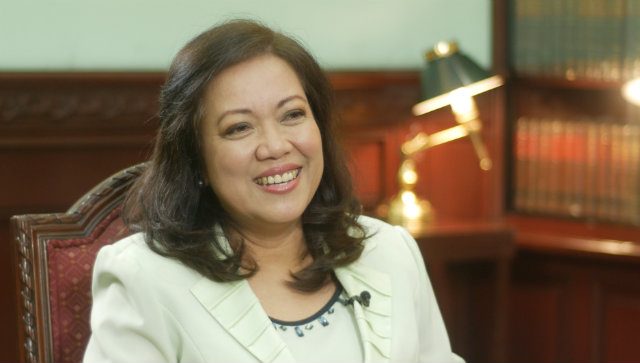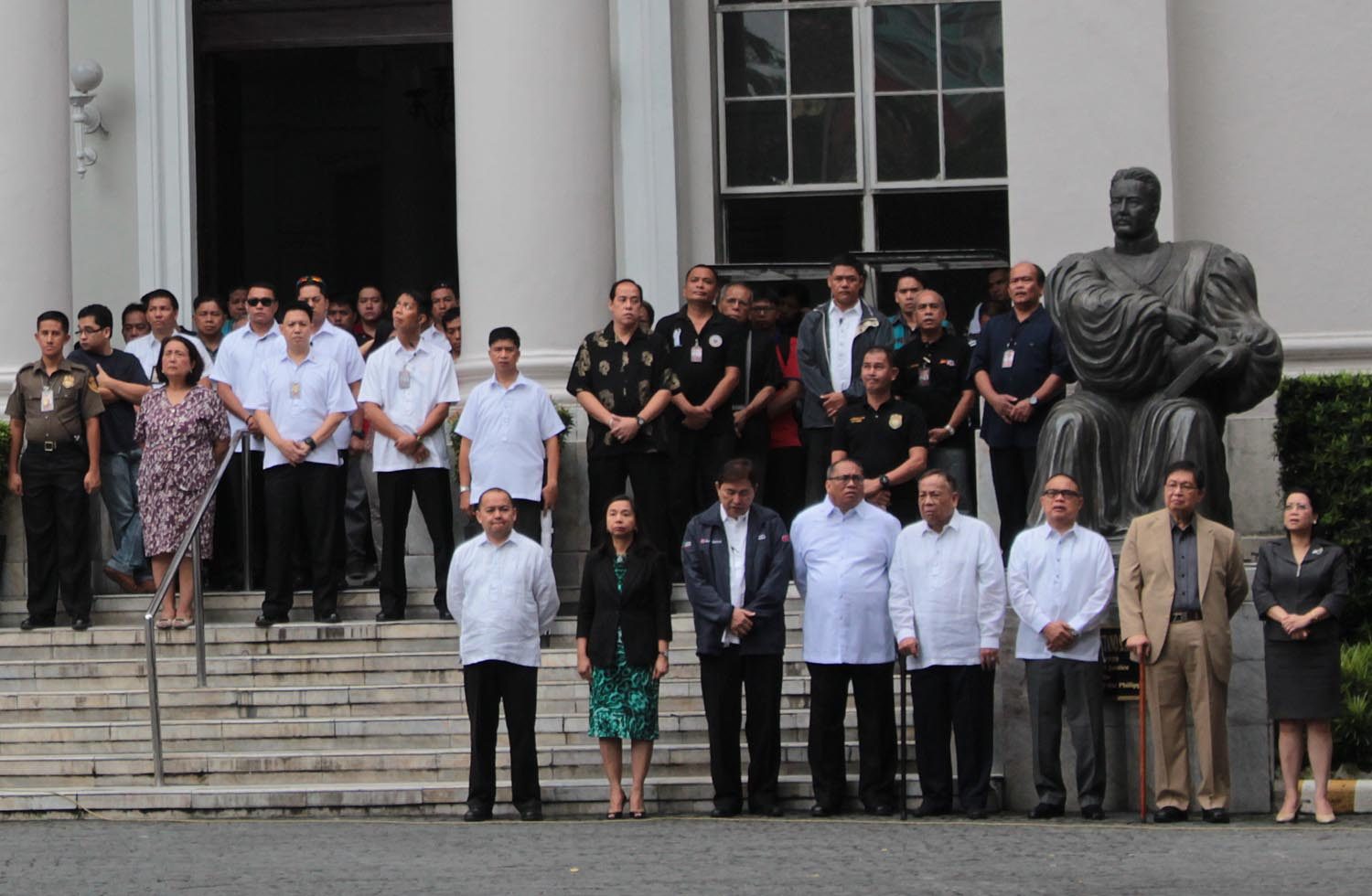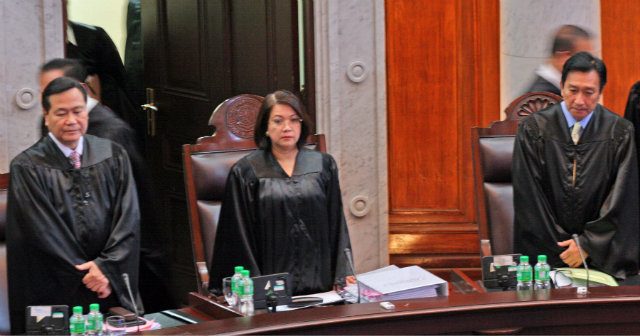SUMMARY
This is AI generated summarization, which may have errors. For context, always refer to the full article.

MANILA, Philippines – When President Benigno Aquino III broke tradition to appoint the century’s youngest and the country’s first female chief justice in 2012, critics doubted whether Maria Lourdes “Meilou” Sereno can be impartial to the appointing power.
Three years and many controversies later, Sereno is visibly at ease as she talks about leading the Supreme Court, and what she considers to be her best achievement so far.
“The perception that people believe that the Chief Justice is independent,” Sereno said in response to a question from Rappler CEO and Executive Editor Maria Ressa.
“It is important because it is only when a chief justice and her colleagues in the Court are independent that we can actually have a rule of law regime,” she said in a rare, exclusive interview.
Sereno took over the High Court after the tumultuous impeachment trial of former Chief Justice Renato Corona. Then a 52-year-old junior associate justice, she had to lead a divided institution, work with colleagues she bypassed in her appointment, and address the perception that her previous decisions favored the administration.
As she marks her 3rd year in office in August, Sereno looks back at the start of a record 18-year term. In her first years, the Court handed down historic rulings abolishing the graft-tainted Priority Development Assistance Fund (PDAF) or pork barrel, and striking down some acts under the administration’s stimulus measure, the Disbursement Acceleration Program (DAP).
It was the Court’s unanimous decision on DAP that sparked scathing criticism from Aquino, pitting the executive against the judicial branch of government. At the height of the word war, Sereno stood by the ruling. (READ: Aquino and the Sereno Court)
In the personal, wide-ranging interview with Rappler, the Chief Justice said respect for the branches of government characterizes her judicial philosophy.
“The most important thing that everyone must understand is the Constitution did not really design governance to be personalistic. There are very strong fundamental principles embedded in the Constitution. If I am going to summarize it in one word, it’s really respect: respect for co-equal branches, but also respect for the lines that should be drawn,” she said.
Sereno stressed that strengthening institutions is her first “order of the day.”
“If you can imagine democracy where all the constitutionally designated offices were to be professional and independent, then you would not have had this mess about public funds being spent allegedly in the magnitude of billions of pesos. You don’t have belated audit findings decades after the money is no longer available for retrieval,” she said.
With her term spanning 4 presidents until she reaches the mandatory retirement age of 70 in 2030, Sereno takes the long view.
“If we emphasize institutions over personality, we have a chance of being a modern nation.”

‘Leadership by consensus’
Sereno talked about the institution she now heads: the judiciary.
Besides independence, the chief magistrate counts as her accomplishment programs meant to reform the Philippines’ notoriously snail-paced justice system. These include an automation project, an electronic court system, continuous trials, and a court decongestion program. (READ: Sereno: Justice must be real-time, high-tech)
These are under what Sereno calls her 4 pillars of judicial and legal profession reform:
- Institutionalized integrity and increased credibility
- Rational, predictable, speedy and appropriate judicial actions
- Improved systems, processes and infrastructure
- Effective and efficient human resources
‘This is something I am very proud of: that this court, regardless of the fact that a lot of emotions accompanied my appointment, actually proved to be professional in every sense.’
– Maria Lourdes Sereno, Chief Justice
While her predecessors just had an average of a little over 3 years in office, Sereno knows she has almost two decades to implement structural reforms.
“I can’t believe that in the 3 years I’m here, that changes will be embraced by employees in this manner. The pressure is enormous because the hope, you can feel it. It’s in the air. They want you so much to succeed. You don’t want to fail the people but at the same time, you recognize that not all the factors are within your control,” she said.
One factor that was beyond Sereno’s control was the initial tension with senior justices sidelined by what she concedes to be her “rise from nowhere.”
When she became the Supreme Court’s primus inter pares (first among equals), Sereno was only a member of the Court for two years despite her background in law and the academe.
She was executive director of the Asian Institute of Management Policy Center, taught at the University of the Philippines College of Law for 20 years, and was co-counsel in the government’s case involving the establishment of the Ninoy Aquino International Airport III.
Sereno had a tough time starting out as chief justice. Her colleagues reportedly skipped flag ceremonies and weekly lunches after their en banc meetings. Recently, Associate Justice Francis Jardeleza took a swipe at Sereno and Senior Associate Justice Antonio Carpio for opposing his appointment.
At 55, the Chief Justice admits she had to adapt to lead an institution steeped in hierarchy and tradition.
“I did not consider my being young as an inherent obstacle. I thought that there were things I had to adjust to more, and that my expectations had to be lowered because of that … You have to earn the respect of people, and show your leadership.”
She calls her management style “leadership by consensus.”
“The fact that there are alternative views, instead of being rejected outright by me, actually provided a better alternative. Wisdom is not the monopoly of any one person. When a course of action has to be adjusted because there are dangers being pointed out to you by your colleagues, it would be wise to listen to those warnings,” she said.
In a collegial body like the Supreme Court, she said she makes it a point to encourage more discussion.
“That is one thing I appreciate from my colleagues. The discussion in the en banc has been very dynamic. Everyone is free to give his input,” she said.
“This is something I am very proud of: that this court, regardless of the fact that a lot of emotions accompanied my appointment, it actually proved to be professional in every sense.”

What after #CJPaSiSereno?
Beyond the Supreme Court, Sereno reached out to other members of the justice sector through regular dialogue with lower courts, prosectors, public attorneys, the police, and the justice department.
“We should no longer be thinking in terms of silos where we think our terms of reference ends here, and I don’t really care what happens to the other branches. No, we must care, and we must show our people that we care enough so we talk, we coordinate, we harmonize our rules to the extent where it is possible,” she said.
The Chief Justice also seeks to reach the wider public. Under Sereno, the Supreme Court opened oral arguments through an audio livestream, and issued new guidelines for the release of justices’ Statement of Assets, Liabilities and Net Worth. She also started an unprecedented annual meet-the-press session.
A believer in the power of technology, Sereno said she is “sensitive to communication,” even citing her interview with Rappler as an example.
“Rappler has a very dynamic format so I thought it would be an interesting experiment trying to communicate using that format,” she said.
‘I did not consider my being young as an inherent obstacle … You have to earn the respect of people, and show your leadership.’
– Maria Lourdes Sereno, Chief Justice
The first female chief justice said being a woman influences how she communicates, and leads the Court.
“My approach is mind-mapping. It’s very intuitive, more feminine than masculine. I have quite a strong sense of a collective feel for something, and I am able to show that I speak from within. Some say from the heart then because I think it’s important to appeal to the deepest values of the people,” she said.
She added that her husband and two children also go by her “principle of self-limiting,” or living below her means, and associating with few people to avoid vested interests.
“I am not embarrassed by saying it but everyone in my family has seen [my job] as a charge from God. If it is a charge, if it is a trust, you can’t even think of abusing it. That’s dangerous. That would be the most treasonous thing to do,” Sereno said.
Joking about the youth and technology, Sereno said she thought about speaking in hashtags for this interview.
One hashtag that went wild when news about her appointment broke was #CJPaSiSereno. Amused with having one of the longest-serving chief justices, netizens posted, “May nakatira na sa Mars, #CJPaSiSereno!” (Someone already lives in Mars, Sereno is still CJ.)
What does she want to leave behind under #CJPaSiSereno?
“Consistency for 18 years, upholding the Constitution, a life of integrity outward and inward, and unwavering fealty to those I love: God, love, family, and of course, my expanded family now, the judiciary.” – Rappler.com
Add a comment
How does this make you feel?
There are no comments yet. Add your comment to start the conversation.